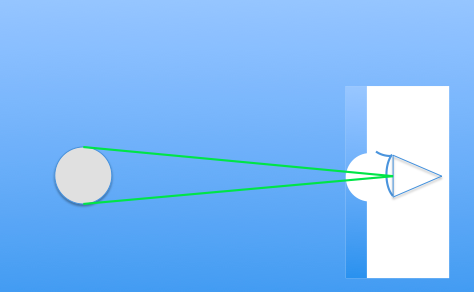Qualitatively, the thing that happens under water (when you wear a diving mask) looks like this:

The green lines represent the path the light would have taken without the water, and therefore the "apparent size" of the bubble. But as you can see, the refraction of the light away from the normal (transitioning to a medium of lower refractive index) causes the angle at which the light appears at the eye to change - and since the angle subtended by the object is larger, it "appears" larger (for the given distance).
Goggles that are slightly curved (with the center of curvature at the lens of the eye) prevent this from happening - it's almost as if you had put a lens with a negative focal length on the inside of your goggles:

Mathematically, if $d_1 \gg d_2$ and the diameter of the bubble is much less than the distance to the goggles, you can deduce the change in angle straight from Snell's Law, and conclude the bubble is $n_{water}$ greater than it would be if observed "normally". Since it is observed to be 1.5 cm, we conclude its real size is 1.5/1.33 = 1.1 cm (25% smaller).
The presence of glass (N~1.5) between the water and the air inside the goggles doesn't change the answer - because if we call the intermediate refractive index $n_i$ and the intermediate angle $\theta_i$, we can write Snell's Law in two parts:
$$n_w \sin\theta_w = n_i \sin \theta_i = n_a \sin \theta_a$$
Leaving out the bit in the middle, you see that the refractive index of the glass does not, in fact, affect the magnification. But the curvature of the glass does - very much.
Just as you can think of the curved goggles (my second diagram) as "correction" for the magnification (as you know, lenses with negative focal length make things look smaller), so you can consider the original situation as a "positive" lens - since, depending on their path, the rays traverse a different amount of water. I am struggling a bit to find a good way to represent that graphically - but it's basically the counterpoint to the second diagram above. And having a positive lens in the path causes magnification, of course.
If the "underwater swimmer" in the question was not wearing goggles, he/she would have a hard time focusing on the bubble (since the refractive power of the eye mostly comes from the interface of the cornea and the air - replace the air with water and you have a very poor lens).
If you could see properly with your eyes under water (you had some amazing internal lensing mechanism) you would see the bubble with its usual angular size. Wondering how big it is, you could bounce a LIDAR signal off the bubble and deduce, from the round trip tipe, how far away the bubble is. Under water, that signal would take $n_w$ times longer than in air. So if the same angular size appears to be further away, you once again conclude that the bubble is $n_w$ times larger than it really is.





